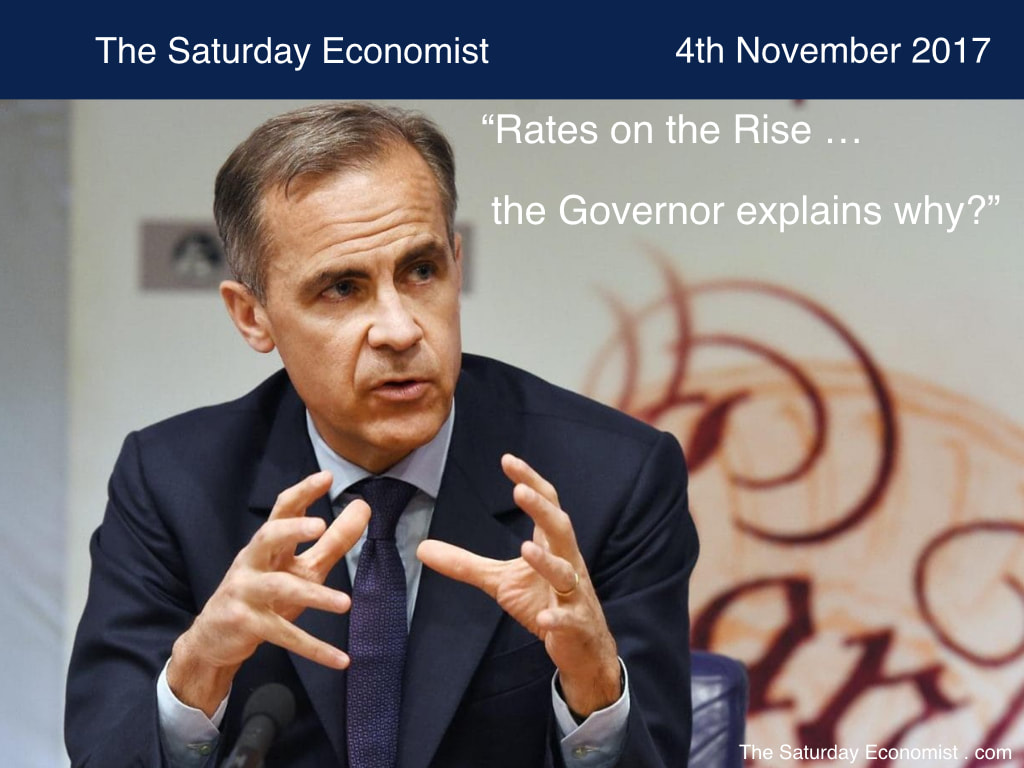|
The Bank of England increased base rate this week. It was the first rate hike in a decade. More of a nudge than a hike, the decision to increase base rate to 0.5% merely returned interest rates to the "status quo ante referendum". The move to cut rates in August last year was considered by many to be a mistake. The move compounded the weakness of Sterling, increasing the pressures on inflation into 2017. So why has the bank acted now? Growth has softened into the third quarter, concerns about Brexit persist. The Bank of England is seriously concerned about jobs, incomes and investment as a result of the Brexit decision. "In many respects the decision was straightforward" explained the Governor, "With inflation high and slack disappearing, the economy is growing at rates above it's speed limit. Inflation is unlikely to return to the 2% rate without some increase in interest rates." Mmmm Was it really so straightforward? Not all MPC members were convinced. Sir Jon Cunliffe, Deputy Governor for Financial Stability and Dave Ramsden, Deputy Governor for Markets voted against the rate rise. Two out of three deputies were doves. Just one was a hawk. Ben Broadbent, Deputy Governor for Monetary Policy voted for the rate rise. Later he warned that the interest rate increases would mean pain for households. How things have changed. Ben was still at Cambridge when a rate rise of 25 basis points would appear as a Threadneedle Street typo. In the late 80's Rates increased from 9% to 16% in a two year period. At that time, the Bank of England did not consider interest rates had any impact on consumer spending at all. Keynes' would have us believe that interest rates impact only on the investment cycle. So much for home ownership and mortgage finance! Never a feature of the Keynes' data bank. So why hike now? The MPC primary responsibility is price stability defined as a 2% CPI inflation target. Inflation was 3% in September. It is expected to have risen a little further in October according to the Governor. Further rate rises will occur at a gradual pace and to a limited extent. Forward guidance returns. Market expectations are for two further 25 basis points increases over the next three years. Sterling slipped as the Bank announced the decision. Markets rallied as improved dollar earnings will feed into profits. The Bank has made the move to follow the Fed. So what is the path of future interest rates? The answer may well lie in the Pink Book, published last week without too much coverage … The Balance of Payment Pink Book was published last week. The data for 2016 confirmed a widening of the current account deficit to 5.9% of GDP. The deficit widened to the largest since records began in 1946. The trade deficit in goods was £135 billion, offset by a £93 billion surplus on services. In the current year we expect comparable figures to be £140 billion and £100 billion. The overall trade in goods and services deficit is 2.2% of GDP. Of itself a slight concern but fundable given the kindness of strangers and a soft spot for soft yields. The problem in 2016 was the deterioration in the net investment position. The primary income deficit increased to 2.6% of GDP. UK earnings on assets abroad have fallen relative to earnings on foreign investment in the UK. This is the first time the deficit has appeared since records began in 1997. The UK stock of international investments was negative by just over £20 billion. The depreciation of Sterling flattered the overall position. We have seen large deficits on current account before but not to this extent. In 1989 the deficit neared 5% of GDP. Base rates were hiked to 15% to inhibit domestic demand and prevent a run on Sterling. In 1974, the deficit hit 4% of GDP. Rates were hiked to 14%. The Treasury was forced to turn to the IMF for help. The Governor believes that two modest rate rises over the next three years will do the job this time round. "The kindness of strangers, with inky blots and rotten bonds sustained" may yet be exhausted if the Brexit outcome appears too harsh for future earnings and yields. Concerns will fail to be alleviated by a further fifty basis points rise in rates. If external pressures materialize, we will see the real pain for households to which Ben Broadbent alludes … © 2017 John Ashcroft, Economics, Strategy and Social Media, experience worth sharing. ______________________________________________________________________________________________________________ The material is based upon information which we consider to be reliable but we do not represent that it is accurate or complete and it should not be relied upon as such. We accept no liability for errors, or omissions of opinion or fact. In particular, no reliance should be placed on the comments on trends in financial markets. The receipt of this email should not be construed as the giving of advice relating to finance or investment.
0 Comments
Leave a Reply. |
The Saturday EconomistAuthorJohn Ashcroft publishes the Saturday Economist. Join the mailing list for updates on the UK and World Economy. Archives
July 2024
Categories
All
|
| The Saturday Economist |
The material is based upon information which we consider to be reliable but we do not represent that it is accurate or complete and it should not be relied upon as such. We accept no liability for errors, or omissions of opinion or fact. In particular, no reliance should be placed on the comments on trends in financial markets. The presentation should not be construed as the giving of investment advice.
|
The Saturday Economist, weekly updates on the UK economy.
Sign Up Now! Stay Up To Date! | Privacy Policy | Terms and Conditions | |

 RSS Feed
RSS Feed